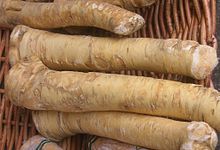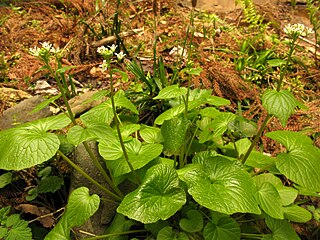
Wasabi or Japanese horseradish is a plant of the family Brassicaceae, which also includes horseradish and mustard in other genera. The plant is native to Japan and the Russian Far East including Sakhalin, as well as the Korean Peninsula. It grows naturally along stream beds in mountain river valleys in Japan.

A condiment is a preparation that is added to food, typically after cooking, to impart a specific flavor, to enhance the flavour, or to complement the dish. A table condiment or table sauce is more specifically a condiment that is served separately from the food and is added to taste by the diner.

The radish is an edible root vegetable of the mustard family, Brassicaceae, that was domesticated in Asia prior to Roman times.
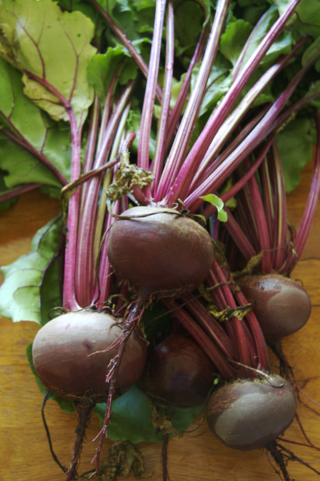
The beetroot is the taproot portion of a beet plant, usually known in North America as beets while the vegetable is referred to as beetroot in British English, and also known as the table beet, garden beet, red beet, dinner beet or golden beet.

In organic chemistry, isothiocyanate is a functional group as found in compounds with the formula R−N=C=S. Isothiocyanates are the more common isomers of thiocyanates, which have the formula R−S−C≡N.
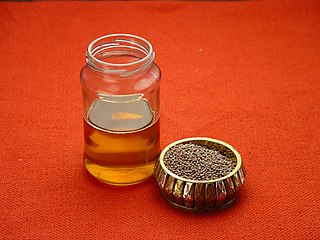
Mustard oil can mean either the pressed oil used for cooking, or a pungent essential oil also known as volatile oil of mustard. The essential oil results from grinding mustard seed, mixing the grounds with water, and isolating the resulting volatile oil by distillation. It can also be produced by dry distillation of the seed. Pressed mustard oil is used as cooking oil in some cultures, but sale is restricted in some countries due to high levels of erucic acid. Varieties of mustard seed also exist that are low in erucic acid.

Allyl isothiocyanate (AITC) is a naturally occurring unsaturated isothiocyanate. The colorless oil is responsible for the pungent taste of cruciferous vegetables such as mustard, radish, horseradish, and wasabi. This pungency and the lachrymatory effect of AITC are mediated through the TRPA1 and TRPV1 ion channels. It is slightly soluble in water, but more soluble in most organic solvents.

Glucosinolates are natural components of many pungent plants such as mustard, cabbage, and horseradish. The pungency of those plants is due to mustard oils produced from glucosinolates when the plant material is chewed, cut, or otherwise damaged. These natural chemicals most likely contribute to plant defence against pests and diseases, and impart a characteristic bitter flavor property to cruciferous vegetables.

Myrosinase is a family of enzymes involved in plant defense against herbivores, specifically the mustard oil bomb. The three-dimensional structure has been elucidated and is available in the PDB.

Gluconasturtiin or phenethyl glucosinolate is one of the most widely distributed glucosinolates in the cruciferous vegetables, mainly in the roots, and is probably one of the plant compounds responsible for the natural pest-inhibiting properties of growing crucifers, such as cabbage, mustard or rape, in rotation with other crops. This effect of gluconasturtiin is due to its degradation by the plant enzyme myrosinase into phenethyl isothiocyanate, which is toxic to many organisms.

Gold Pure Food Products Co., Inc. is an American food-manufacturing company located in Hempstead, New York all of whose products have OU Kosher supervision.
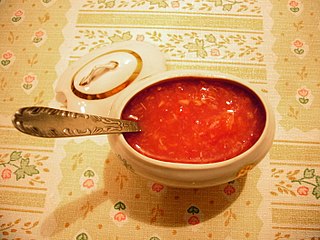
Khrenovina sauce is a spicy horseradish sauce served with a main course, popular in Siberia. It is prepared by blending fresh tomatoes, horseradish, garlic and salt. Ground black pepper, ground paprika, sweet bell pepper, vinegar, and sugar may also be added. It may be served with traditional Russian meat dishes, including pelmeni.
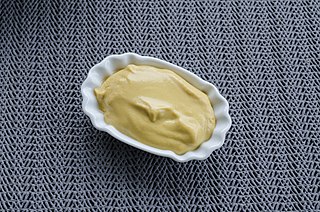
Mustard is a condiment made from the seeds of a mustard plant.

Chrain is a spicy paste made of grated horseradish. It is a common condiment for meat and fish dishes in Eastern and Central European cuisines. Chrain comes from Yiddish כריין, which is in turn a loanword from Slavic languages.

Silver Spring Foods, Inc., is the world's largest grower and producer of horseradish. Founded in 1929, the company is based in Eau Claire, Wisconsin and also produces an assortment of sauces and mustards. The company was incorporated in 1949 as Silver Spring Gardens.

Phaedon cochleariae is a non-social, holometabolous species of leaf beetle native to Europe.

